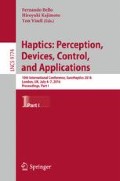Abstract
This paper proposes a method to further enlarge the displayed stiffness range of the impedance-type haptic interfaces. Numerous studies have been done for a stable haptic interaction in a wide impedance range. However, most of the approaches sacrifice the actual displayed stiffness as a cost of stability. A novel approach, which successively increases the stiffness as the number of interaction cycle increase, is presented. The stiffness is sequentially modulated from a low value to a high value, close to the desired stiffness while maintaining stability. This sequential stiffness increment was possible because the proposed approach guarantees the convergence of the penetration distance and increases the feedback force with every successive interaction cycle. The main advantage of the proposed approach over conventional approaches is that this approach allows much larger actual displayed stiffness than any other approach, such as time-domain passivity approach, force bounding and energy bounding approach. Experiments with PHANToM Premium 1.5 evaluate the performance of the proposed approach, and compare the actual displayed stiffness with other approaches.
Access this chapter
Tax calculation will be finalised at checkout
Purchases are for personal use only
References
Bolanowski, S.J., Gescheider, G.A., Verrillo, R.T.: Hairy skin: psychophysical channels and their physiological substrates. Somatosens. Mot. Res. 11(3), 279–290 (1994)
Niemeyer, G., Slotine, J.-J.E.: Stable adaptive teleoperation. IEEE J. Oceanic Eng. 16(1), 152–162 (1991)
Hannaford, B., Ryu, J.-H.: Time-domain passivity control of haptic interfaces. IEEE Trans. Robot. Autom. 18(1), 1–10 (2002)
Ryu, J.-H., Yoon, M.-Y.: Memory-based passivation approach for stable haptic interaction. IEEE/ASME Trans. Mechatron. 19(4), 1424–1435 (2014)
Kim, J.-P., Ryu, J.: Energy bounding algorithm based on passivity theorem for stable haptic interaction control. In: 12th International Symposium on Haptic Interfaces for Virtual Environment and Teleoperator Systems, 2004, HAPTICS 2004, Proceedings, pp. 351–357, March 2004
Kim, J.-P., Baek, S.-Y., Ryu, J.: A force bounding approach for multi-degree-of-freedom haptic interaction. IEEE/ASME Trans. Mechatron. 20(3), 1193–1203 (2015)
Jafari, A., Ryu, J-H.: Input-to-state stable approach to release the conservatism of passivity-based stable haptic interaction. In: 2015 IEEE International Conference on Robotics and Automation (ICRA), pp. 285–290, May 2015
Llewellyn, F.B.: Some fundamental properties of transmission systems. Proc. IRE 40(3), 271–283 (1952)
Hogan, N.: Controlling impedance at the man/machine interface. In: 1989 IEEE International Conference on Robotics and Automation, 1989, Proceedings, vol. 3, pp. 1626–1631, May 1989
Colgate, J.E., Stanley, M.C., Brown, J.M.: Issues in the haptic display of tool use. In: 1995 IEEE/RSJ International Conference on Intelligent Robots and Systems 1995, Human Robot Interaction and Cooperative Robots, Proceedings, vol. 3, pp. 140–145. IEEE (1995)
Acknowledgment
This paper is supported by the project (Development of core teleopertion technologies for maintaining and repairing tasks in nuclear power plants) funded by the Ministry of Trade, Industry & Energy of S. Korea.
Author information
Authors and Affiliations
Corresponding author
Editor information
Editors and Affiliations
Rights and permissions
Copyright information
© 2016 Springer International Publishing Switzerland
About this paper
Cite this paper
Singh, H., Jafari, A., Ryu, JH. (2016). Successive Stiffness Increment Approach for High Stiffness Haptic Interaction. In: Bello, F., Kajimoto, H., Visell, Y. (eds) Haptics: Perception, Devices, Control, and Applications. EuroHaptics 2016. Lecture Notes in Computer Science(), vol 9774. Springer, Cham. https://doi.org/10.1007/978-3-319-42321-0_24
Download citation
DOI: https://doi.org/10.1007/978-3-319-42321-0_24
Published:
Publisher Name: Springer, Cham
Print ISBN: 978-3-319-42320-3
Online ISBN: 978-3-319-42321-0
eBook Packages: Computer ScienceComputer Science (R0)

